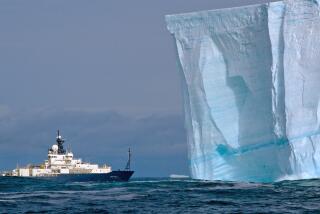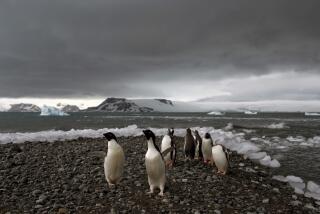Dividing the Pie : History in Making at South Pole
- Share via
AT THE SOUTH POLE — Outside the geodesic dome of the U.S. Science station here, the temperature stood at 21 degrees below zero; a brisk wind blew ice crystals into swirls and pulled heat from humans like a vacuum pump. But never mind. Abdul Koroma had a chance to make history, and make it he would.
Trudging toward the ceremonial barber pole that marks the southernmost point on Earth, the ambassador to the Permanent Mission of Sierra Leone to the United Nations carried a small wooden sign announcing his arrival. He was about to become the first Sierra Leonean, and perhaps the first black African, to reach the South Pole.
Koroma plunged the sign’s stake into the snow and mused quietly for a few moments. Then he posed for photographs. Six thousand miles away the citizens of Freetown, Sierra Leone’s capital, were going about their business as usual, most likely unaware of this moment in their history. Would they ever know?
Important Moment
Drawing himself to his full height and obviously thinking more of his countrymen than himself, Koroma declared, “I will inform Freetown.” Then, history having been accomplished, Koroma marched back to the science dome in his white polar boots for a lunch of chicken and fries.
For Koroma his presence here was not without its irony. One hundred seventy-seven years ago the British had marched through Sierra Leone on their way to colonizing huge chunks of Africa. They ruled Koroma’s country for 153 years, letting go in 1961.
Now Koroma and a handful of other Third World diplomats had been invited here--along with the British and most other Western nations--to talk about dividing the pie of another continent, Antarctica. This time, Sierra Leone wanted its share.
“If you look at Antarctica today it reminds you of the scramble for Africa,” Koroma said. “Nations have planted their flags and there is talk of great riches. We asked ourselves, ‘Why should the developed nations be the only beneficiaries?’ ”
River of Ice Nearby
The conference attended by Koroma and 57 other diplomats and scientists from 28 countries was one of the most unusual on record. Organized by the United States, it was held 450 miles from the South Pole on an ice field in the midst of the Transantarctic Mountains. Nearby was the Beardmore Glacier, the huge river of ice used 72 years ago by Robert Falcon Scott on his doomed journey to the pole.
The site, with its towering peaks and intertwining glaciers, is considered one of the most spectacular in all of Antarctica. And one of the most isolated: The conference members were ferried to the glacier by ski-equipped C-130 Hercules aircraft and housed in a small collection of insulated Quonset huts known as Janesways.
For four days--with the exception of the side trip to the pole--the conferees ate, slept, showered and argued with each other as they moved from hut to hut in unusually balmy 15-degree weather. Next year the assembly of huts, called the Beardmore South Camp, will be used as a base for U.S. scientific expeditions here.
The centerpiece of the debate was the 25-year-old Antarctica Treaty, which has governed virtually all activities here since it was signed by a group of 12 nations that had either scientific or territorial interest in the continent. The original signatories were the United States, the Soviet Union, Great Britain, France, Japan, Chile, Belgium, Argentina, Australia, New Zealand, Norway and South Africa.
Since the original signing four additional countries--Poland, India, Brazil and West Germany--have joined the treaty as full-fledged members, which are known as “consultative parties.”
From the point of view of the Third World representatives, the Antarctica Treaty is a relic of the past when the Western world divided up sections of the globe for their own purposes and more or less ignored the interests of other nations.
As he wandered outside the Beardmore Camp during a break in the proceedings, the Malaysian ambassador to the United Nations described the treaty as a “historical anomaly.”
“Here is a whole continent,” said Azraai Zain, his arm sweeping around the vast landscape. “A group of countries have maintained to themselves an exclusive right to make all decisions about Antarctica. We have to ask ourselves, ‘Why is that?’ ”
Zain, along with representatives of other developing nations, suspects that the reason may be natural resources. For most of this century, Antarctica was universally regarded as a frozen wasteland, suitable only for the exploits of marginally sane explorers and scientists.
Mineral Wealth
But during the 1970s the possibility was raised that Antarctica might contain hidden wealth. In the wake of the Arab oil embargo the United States, Japan and other countries conducted preliminary oil surveys in the continent’s offshore regions, and made optimistic projections based on the sketchy evidence obtained.
Other treaty nations began to cast about for coal, iron, uranium and other hard minerals in Antarctica and in some cases reported favorable initial results. Japan, the Soviet Union and Poland actually began to exploit one living resource--a shrimp-like crustacean known as krill--in fleets of trawlers off the continent’s coast. Some nations also began to look at icebergs as a source of fresh water.
More recently, the treaty nations have striven to diminish the economic value of these resources. The initial reports often were overly optimistic, they now claim, pointing out that not one exploitable mineral resource has been found in Antarctica.
But the point had not been missed in the Third World: No one knew what resources were, or were not, to be found in Antarctica. And as things stood, only the treaty nations had the keys to the locked doors of the continent.
“The treaty nations now say to us, ‘Don’t worry, there are no resources.’ Or they say, ‘Don’t worry, it will be 50 years before the resources are developed,’ ” Zain said. “But they are worrying, and we can see that. So why shouldn’t we worry?”
So concerned were the Third World nations that last year they asked the U.N. General Assembly to take up the “question of Antarctica.” Implied in the request was the possibility that another system of rule might be proposed for the continent.
No action was taken by the General Assembly but the conference at Beardmore South Camp was, in part, the response of the treaty nations to the Third World initiative. Everyone would go to a glacier in Antarctica and worry together.
For the organizers, the Beardmore site was a shrewd choice. It is dramatic, with 13,000-foot mountains rising spookily out of a sea of ice. It is also totally isolated and obviously dangerous to unprotected humans. When discussions touched on the prospects for oil and mineral exploitation, the diplomats needed only to look out a window for a full appreciation of the difficulties involved.
“When I first saw it, I realized I could never have imagined anything like this,” said Domingo Da-Fieno, chief of the political department at the Peruvian Embassy in Washington. “You hear about Antarctica, you can see pictures of it, but that’s not the same as this.”
Clearly, this was one of the impressions the organizers had hoped to achieve. It was one thing, they reasoned, to sit in the United Nations and talk about the riches of a new continent; it was another to sit on top of a glacier and picture miners hauling iron ore over hundreds of miles of frozen landscape to a port where ships constantly dodge icebergs.
“We are about to embark on an adventure, but an adventure with a purpose,” James H. Zumberge, the chairman of the conference, told the delegates the night before they flew from Christ Church, New Zealand, to the Beardmore Camp. Zumberge, who is also the president of the University of Southern California, has spent several seasons here pursuing his academic speciality of glaciology and has edited a report on the environmental effects of Antarctic development.
“You will experience the enormous logistical requirements of a place that demands $10 in life support for every $1 spent on science. You will see that Antarctica is a cost center, not a profit center,” Zumberge said.
Inside the Beardmore huts, Zumberge’s colleagues--a collection of Antarctic scientists and diplomats from the treaty countries--tried to hammer home their arguments with a wearisome list of papers on the virtues of the treaty and the distant prospects for resources development.
The petroleum estimates of 45,290 billion barrels of oil along Antarctica’s continental shelf, they noted, were based on the crudest evidence; not one barrel of oil has been proved to exist in Antarctica. Even if oil does exist, said Geoffrey Larminie, a geologist with the British Petroleum Co., present technology is incapable of dealing with the combination of severe weather, huge icebergs and deep water conditions presented by Antarctica.
And predictions of hard minerals, the experts said, had been based largely on what is known as the Gondwanaland thesis. The theory grows out of the now accepted notion that 200 million years ago South America, Africa, Australia and Antarctica were joined in a single land mass known as Gondwanaland. By comparing geological formations in Antarctica with those known to be productive of minerals on other continents, scientists have projected that similar deposits of copper, uranium and other minerals may exist here.
Such predictions, Larminie argued, remain conjectural and do not take into account the extraordinary cost of mining and transporting the resources to the marketplace. The price of an offshore oil exploration rig in the Antarctic, for example, likely would be three times the cost of a similar rig in Canada’s Beaufort Sea, he said. And the Beaufort Sea, he noted, now has some of the highest drilling costs in the world.
“The strategy for the Third World countries should not be to attach a piece of the mineral resources in Antarctica,” said Lewis Branscomb, former chairman of the National Science Board. “Their strategy should be to attach a piece of the knowledge that comes out of Antarctic scientific research. That will allow them to find more minerals at home than will ever come out of Antarctica.”
These arguments seemed to have a telling effect on at least one diplomat from a developing nation. “What is there to share? We have to be realistic,” said Hassan El-Ghouayel from Tunisia’s ministry of foreign affairs. “There won’t be any profit from mineral exploitation for many decades. It will be much more valuable for us to share the rewards of science in Antarctica.”
Over the previous four days the argument droned on in a steady procession. Late at night, representatives of some of the world’s largest and smallest countries could be seen strolling together over the glacier, their heads bent in concentration, while a 24-hour sun beamed down on them as bright as noon.
Others repaired to the camp bar, which, for the conference, was stocked with the world’s best Scotch, gin and vodka. The bar came complete with a copper foot rail and, like the sun, operated around the clock when needed.
Occasionally, after a day’s worth of speeches and papers, Zumberge would break out his accordion and lead the bar crowd in a round of drinking songs. One of the most popular was the marching song of the Scientific Committee on Antarctic Research, an international association of South Polar scientists of which Zumberge is now president. It is sung to the tune of the “Happy Wanderer,” and one verse, after listing most of the members of the treaty, concluded this way:
Two more countries make up the list, Chile and the good U.K. There’s hardly room for any more, Let’s keep it all that way. Though the verse was meant as a joke, it went to the heart of a central question confronting the delegates.
Throughout the meetings the diplomats from developing countries described the Antarctic treaty system as an exclusive club in which they--the Third World--would never be regarded as a full-fledged partner.
They pointed out that no African nations except South Africa has ever been made a consultative party to the treaty. And though the treaty system, in theory, is open to any nation, the original parties required that applying countries first demonstrate a “substantial scientific interest” in Antarctica. Such an interest, usually in the form of a land base or research vessel, has been calculated to cost in the neighborhood of $50 million.
“It is a very expensive proposition, joining the Antarctica club,” Zain said. “And that leads us to think that there must be other approaches to the Antarctica question that would be more fair to the world community.”
Just how the developing nations would share in the reward of Antarctica are not clear. But repeatedly during the four days of the conference, the Third World representatives referred to a phrase that was born out of the recent Law of the Sea Treaty.
The phrase is the “common heritage of mankind” and it originally referred to the mineral and other resources of the high seas, which the treaty ruled belonged to all nations equally.
Why should not a similar principal apply to Antarctica? Koroma argued. “We are not asking for a free ride,” he said. “I agree that we should pay our share of exploration cost. Commensurate, of course, with our ability to pay.”
In the face of this, the treaty representatives said they were determined to change the image of their organization. They noted that the last two countries--India and Brazil--admitted as consultative parties do not have full-time research programs on the continent and hinted that further concessions would be made in the future.
Asks for a Chance
“We are asking the new countries to try us out,” said Tucker Scully, the U.S. State Department’s head of ocean and polar affairs. “If we cannot meet their concerns, then they can talk about renegotiating the treaty. But give us a chance first.”
Clearly the concerns of the treaty nations go far beyond the resources questioned. For the 16 signatories, the treaty is close to a holy document. It has kept Antarctica peaceful for 25 years--a unique achievement for a region of international domain--and, more important, has kept the continent off the strategic maps of the Soviet Union and the United States.
“With this treaty we had a full demilitarized zone and on-site inspection,” Scully said. “We could never reproduce that in today’s world. Antarctica would be connected with too many other issues.”
Jose Sorzano of the U.S. Mission to the United Nations is even more blunt. “Once the treaty goes, the Russians and the Americans would be forced to maintain a military presence in Antarctica, and that would cost billions. Neither country wants that.”
Indeed the price of peace in Antarctica has been very cheap to date. At present the United States spends $110 million annually to maintain four scientific bases on the continent. The Soviet Union spends an unknown amount on seven bases. One diplomat here estimated total world expenditures in Antarctica at $200 million to $300 million annually.
The demise of the treaty could also rekindle the nationalistic claims of seven nations to large sections of Antarctica. Under Article IV of the treaty, such claims were set aside as long as the treaty remains in effect. If the treaty goes, supporters say, the claims would resurface with all their potential for conflict.
Armed Disagreements
Such fears are not idle. In the period preceding the treaty, Argentina, Chile and Great Britain held tense confrontations over their joint claims to the Antarctic peninsula region. And in 1952 shots were fired by an Argentine party to dislodge a British expedition from the Hope Bay area.
A final victim to the demise of the treaty likely would be the reign of science on the continent. In the 25 years since the signing of the treaty, science has been the mechanism by which nations have established their presence in Antarctica.
Sometimes the symbols of that occupation are not subtle. At the southernmost spot on the globe--a location visited by many foreign dignitaries--a huge sign spans the arch of the science dome reading: “The United States Welcomes You to the South Pole.”
But if science is superseded by the military, then the treaty members argue that science almost certainly would fade to a secondary presence.
Sense of Camaraderie
“You can compare the situation to our moon project,” Branscomb said. “Science is what we did on the moon, but it was not the reason we went there. It is the same with Antarctica.”
One delegate argued that the Antarctica Treaty should be preserved because it has created the only region on Earth where a wide variety of nations share control and actually seem to grow fonder of each other as time moves on.
“You get outside of Antarctica and the Brits hate the Argentines, the Russians hate the Americans, and vice versa,” said Richard Woolcott, ambassador to the United Nations from Australia. “But down here, they’ve all got their arms around each other. Now that’s worth something.”
Ultimately, no decision was reached at Beardmore. As the meetings drew to an end Zumberge noted that the debate over Antarctica had proceeded for years without the principals ever meeting each other. Now they had, in this extraordinary environment, Zumberge said, and many months might pass before any results were seen. Indeed, there might be no results at all. But at least they had heard each other out.
Then, reflecting the toll that four days of long debate had taken on everyone, Zumberge announced the conference closed, turned to the rear of the room, and said: “Open the bar, please.”
More to Read
Sign up for Essential California
The most important California stories and recommendations in your inbox every morning.
You may occasionally receive promotional content from the Los Angeles Times.










